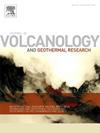晚中新世喷发年代学Peñuela跨墨西哥火山带活动早期形成的火山杂合体
IF 2.3
3区 地球科学
Q2 GEOSCIENCES, MULTIDISCIPLINARY
Journal of Volcanology and Geothermal Research
Pub Date : 2025-05-15
DOI:10.1016/j.jvolgeores.2025.108362
引用次数: 0
摘要
Peñuela火山群位于跨墨西哥火山带(TMVB)的中部。它由上侏罗统至上白垩纪海相沉积序列上的火山圆顶组成。本文介绍了这些圆顶的新地质图、地层、构造和地球化学资料。Peñuela火山杂岩由英安岩系和流纹岩系钙碱性岩系组成。这些序列的新UPb锆石年龄分别为11.72±0.61和10.71±0.19 Ma(晚中新世)。这些年龄与TMVB东部地区火山活动的早期阶段有关。该地区火山活动的特征是在中新世北西-东南向的构造下,形成了从安山岩到英安岩和流纹岩的不同岩石序列。地球化学和岩石学分析表明,岩浆分异作用主要表现为同化作用和不同程度的分异结晶作用。这些结果表明Peñuela火山杂岩是TMVB中新世岩浆事件的一部分,由地壳同化、构造伸展和火山活动的区域尺度迁移形成。本文章由计算机程序翻译,如有差异,请以英文原文为准。
Eruptive chronology of the late Miocene Peñuela Volcanic complex formed during the early stage of activity of the Trans-Mexican volcanic belt
The Peñuela Volcanic Complex is in the central part of the Trans-Mexican Volcanic Belt (TMVB). It consists of volcanic domes emplaced over marine sedimentary successions from the Upper Jurassic to Upper Cretaceous periods. In this paper, we present a new geological map, stratigraphic, structural, and geochemical data of these domes. The Peñuela Volcanic Complex is made of two successions of dacitic and rhyolitic calc-alkaline rocks. New U![]() Pb zircon ages of these successions yielded 11.72 ± 0.61 and 10.71 ± 0.19 Ma (late Miocene). These ages correlate with the early stages of volcanic activity in the eastern sector of the TMVB. Volcanism in the region has been characterized by the emplacement of different successions of rocks ranging from andesitic to dacitic and rhyolitic, under a NW-SE oriented structures that occurred during the Miocene. The geochemical and petrographic analysis shows evidence of magmatic differentiation through a combination of assimilation and different degrees of fractional crystallization. These results suggest that the Peñuela Volcanic Complex is part of a broader Miocene magmatic episode in the TMVB, shaped by crustal assimilation, tectonic extension, and regional-scale migration of volcanic activity.
Pb zircon ages of these successions yielded 11.72 ± 0.61 and 10.71 ± 0.19 Ma (late Miocene). These ages correlate with the early stages of volcanic activity in the eastern sector of the TMVB. Volcanism in the region has been characterized by the emplacement of different successions of rocks ranging from andesitic to dacitic and rhyolitic, under a NW-SE oriented structures that occurred during the Miocene. The geochemical and petrographic analysis shows evidence of magmatic differentiation through a combination of assimilation and different degrees of fractional crystallization. These results suggest that the Peñuela Volcanic Complex is part of a broader Miocene magmatic episode in the TMVB, shaped by crustal assimilation, tectonic extension, and regional-scale migration of volcanic activity.
求助全文
通过发布文献求助,成功后即可免费获取论文全文。
去求助
来源期刊
CiteScore
5.90
自引率
13.80%
发文量
183
审稿时长
19.7 weeks
期刊介绍:
An international research journal with focus on volcanic and geothermal processes and their impact on the environment and society.
Submission of papers covering the following aspects of volcanology and geothermal research are encouraged:
(1) Geological aspects of volcanic systems: volcano stratigraphy, structure and tectonic influence; eruptive history; evolution of volcanic landforms; eruption style and progress; dispersal patterns of lava and ash; analysis of real-time eruption observations.
(2) Geochemical and petrological aspects of volcanic rocks: magma genesis and evolution; crystallization; volatile compositions, solubility, and degassing; volcanic petrography and textural analysis.
(3) Hydrology, geochemistry and measurement of volcanic and hydrothermal fluids: volcanic gas emissions; fumaroles and springs; crater lakes; hydrothermal mineralization.
(4) Geophysical aspects of volcanic systems: physical properties of volcanic rocks and magmas; heat flow studies; volcano seismology, geodesy and remote sensing.
(5) Computational modeling and experimental simulation of magmatic and hydrothermal processes: eruption dynamics; magma transport and storage; plume dynamics and ash dispersal; lava flow dynamics; hydrothermal fluid flow; thermodynamics of aqueous fluids and melts.
(6) Volcano hazard and risk research: hazard zonation methodology, development of forecasting tools; assessment techniques for vulnerability and impact.

 求助内容:
求助内容: 应助结果提醒方式:
应助结果提醒方式:


